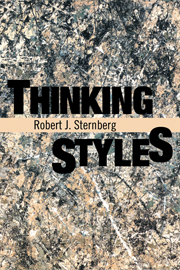6 - The Development of Thinking Styles
Published online by Cambridge University Press: 05 August 2012
Summary
Where do the various styles of intellectual functioning come from? It is certainly possible that at least some portion of stylistic preference is inherited, but I doubt that it is a large part. Rather, styles would seem to be partly socialized constructs, just as is intelligence. From early on we perceive certain styles of interaction with others and with things in the environment to be more rewarded than others, and we probably gravitate toward these styles, at the same time that we have built-in predispositions that place constraints on how much and how well we are able to adopt those rewarded styles. To some extent, society structures tasks along lines that benefit one style or another in a given situation. There is a continuous feedback loop between the exercise of a style and how well that style works in a given societally imposed task. It is important to add that some of the rewards as well as punishments for various styles of interaction are probably internal rather than external. We adopt styles not only in relation to external objects and people, but in relation to ourselves.
VARIABLES IN STYLISTIC DEVELOPMENT
Consider some of the variables that are likely to affect the development of thinking styles.
A first variable is culture. Some cultures are likely to be more rewarding of certain styles than of others. For example, the North American emphasis on innovation and making the “better mousetrap” may lead to relatively greater reward for the legislative and liberal styles, at least among adults.
- Type
- Chapter
- Information
- Thinking Styles , pp. 99 - 112Publisher: Cambridge University PressPrint publication year: 1997
- 1
- Cited by



